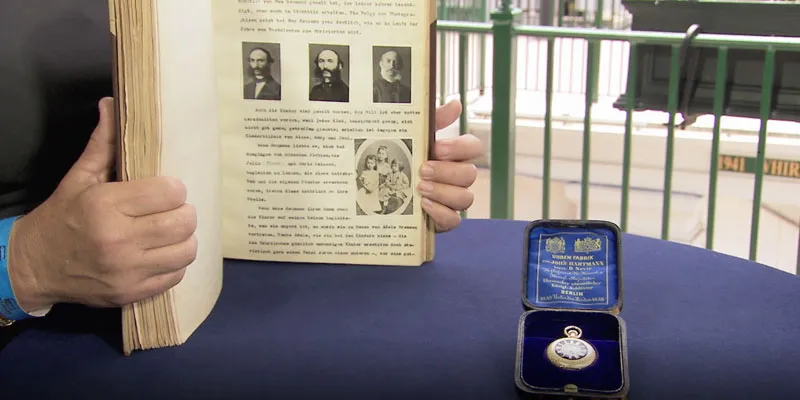How One Woman’s Heirlooms Are Poignant Reminders of a Tragic Past
On April 26, 1938, the Nazi Party declared that all Jews must surrender their possessions to the German government, and that any item was subject to confiscation for the German economy. Yet, one woman’s grandfather, anticipating ramifications of this decree, created a book detailing family treasures and stories for the generations to come.

May 13, 2019
During ANTIQUES ROADSHOW’s May 2018 visit to Churchill Downs Racetrack in Louisville, Kentucky, a guest named Carolyn brought in two different family treasures that each told a powerful story. One of the items was a beautiful solid-gold watch that Carolyn’s great-great-great-grandfather, once one of the wealthiest men in Berlin, purchased for his wife as a gift.
The second item was a book of family history that Carolyn’s grandfather made to preserve their family’s story as Hitler rose to power in the 1930s.
Carolyn explained the poignant origin of the book to Watches appraiser Jeff Cohen:
What I brought here is a family history that my grandfather created in Berlin. He was a Supreme Court judge and was forcibly retired when Hitler came to power. And so, he set out to write the family story, so it would be known. And he gave this to my father when he left on a boat at age 14, to never see his parents again.
For many Jewish families in Germany, the fear of losing family history and treasured personal possessions became more acute on April 26, 1938, when the ruling Nazi Party issued the Decree for Reporting of Jewish Owned Property, stating that “Every Jew … shall report and evaluate in accordance with the following instructions his entire domestic and foreign property and estate on the day when this decree goes into force.”
Yet what really transpired for many families was the brazen confiscation of their property by Nazi officials. As Carolyn described it, in her own family's case, it was none other than Hitler's deputy himself, Hermann Goering, who paid a visit:
”Many of them were taken, as happened to so many Jewish families. And the story goes that Goering actually came to the house before they were deported and 'bought things.'" But they never got paid.”
Having the foresight to document his family’s possessions should they be lost, Carolyn’s grandfather had put together a book that might help the family relocate them in the future, once Hitler’s regime eventually came to an end. The book detailed objects the family owned, including artwork, clocks, trinkets, and photos. One of the pictures in the book shows Carolyn’s great-grandfather meeting Kaiser Wilhelm on the steps of a synagogue.
Examining Carolyn's other family treasure, the watch, Cohen dated it to around 1875, and noted that it is known as a “demi-hunter,” because "you can see the hands without actually having to open the whole cover."
But what makes the watch truly special to Carolyn is the hand-engraved portrait of her great-great-great-grandfather on the inside — the man who gave it as a gift to his wife more than 100 years ago — and today it survives as a treasured memento of Carolyn’s ancestors.
See photos of some of Carolyn’s family heirlooms below.
Related
Watch the full appraisal segment in our Archive
A photo of Carolyn's great-grandfather meeting Kaiser Wilhelm on the steps of a synagogue. Carolyn recalls her great-grandfather's nervousness, "The story goes that he's not sure whether to tip his hat or shake his hand."






